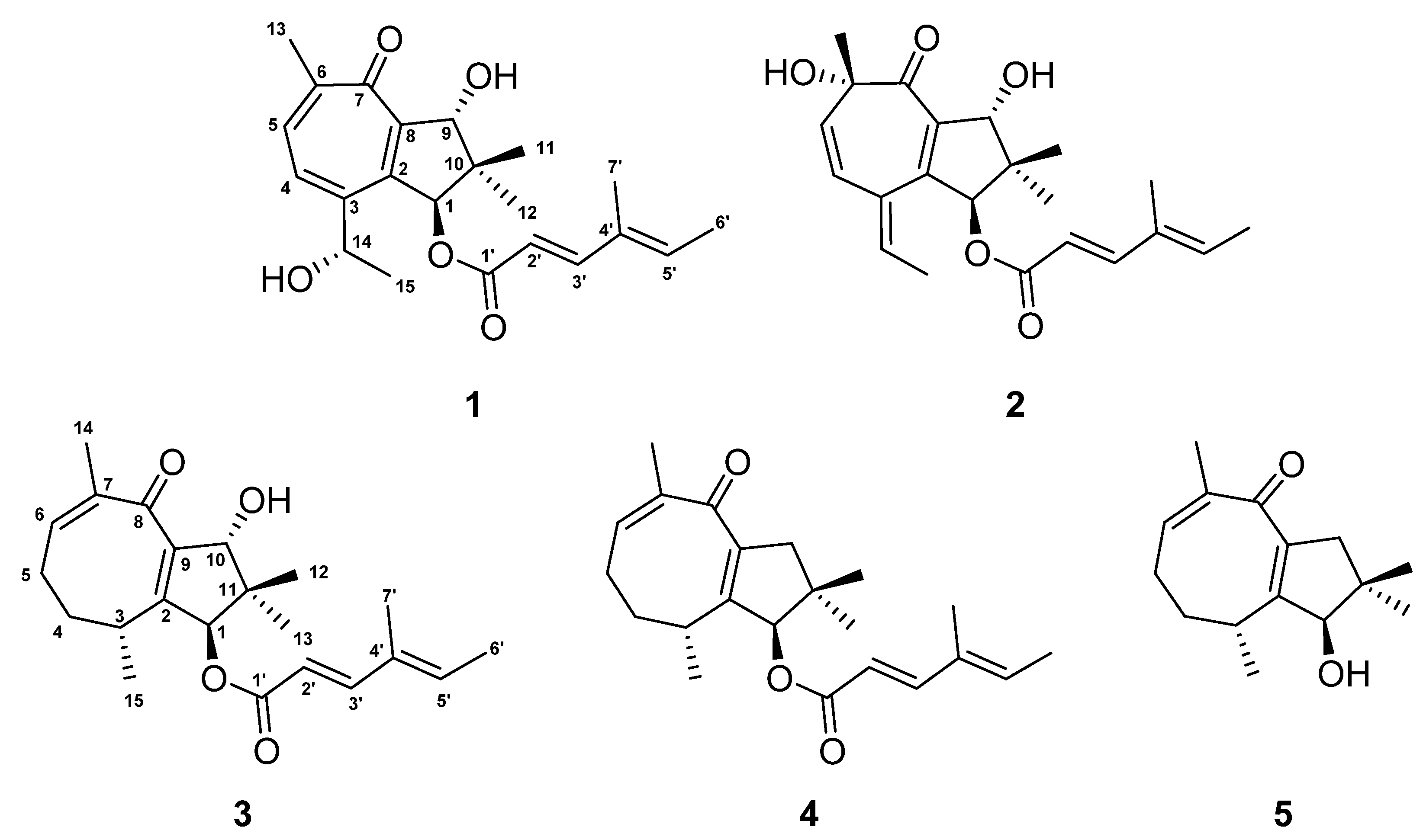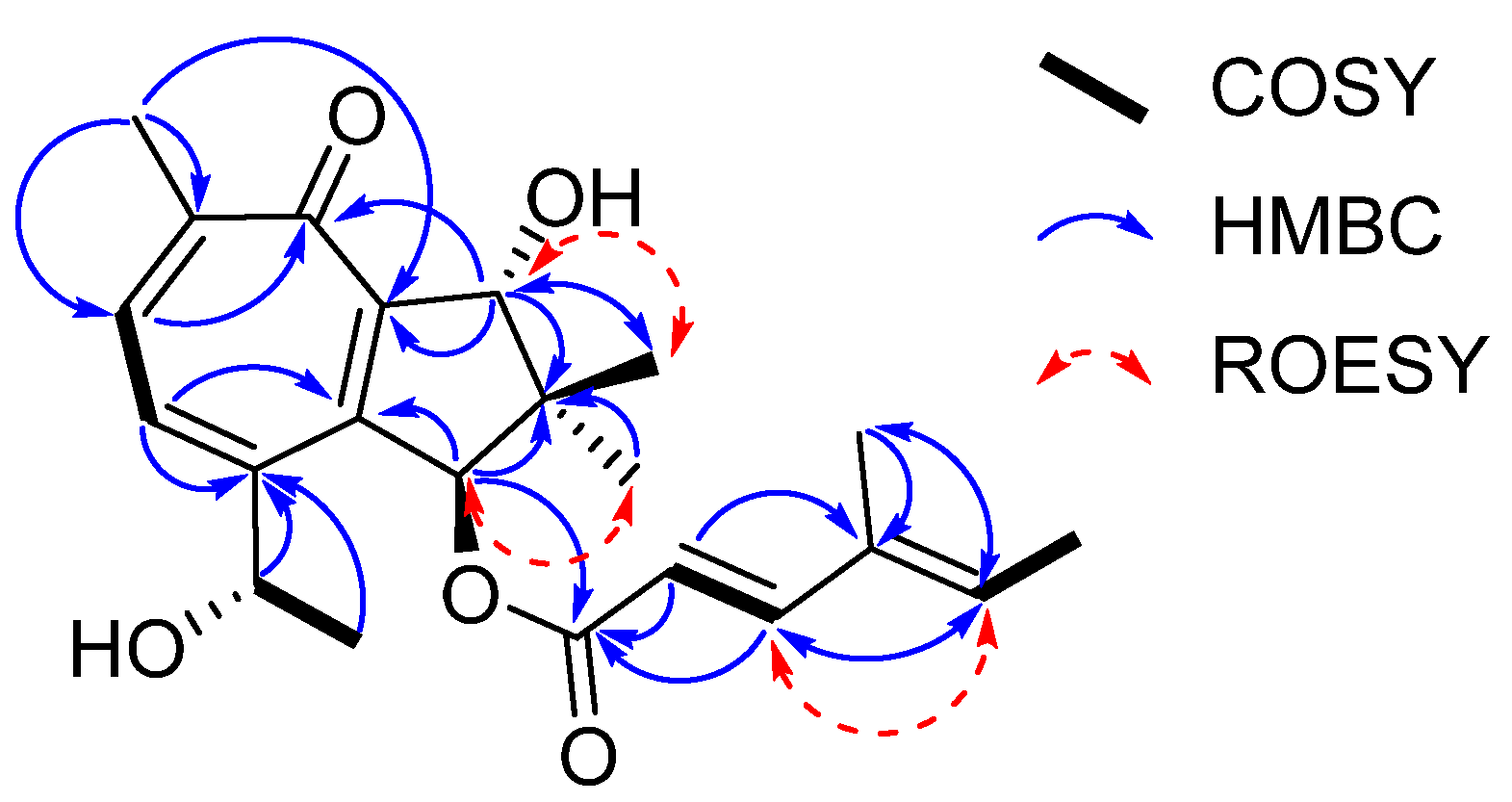Heimionones A–E, New Sesquiterpenoids Produced by Heimiomyces sp., a Basidiomycete Collected in Africa
Abstract
:1. Introduction
2. Results and Discussion
2.1. Isolation and Structure Elucidation of Metabolites from Heimiomyces sp. (Figure 1, Figure 2 and Figure 3)



2.2. Biological Assays
3. Materials and Methods
3.1. General Experimental Procedures
3.2. Fungal Material
3.3. Seed Culture and Fermentation of Heimiomyces sp.
3.4. Harvest and Extraction
3.5. Analytical HPLC
3.6. Isolation of Compounds 1–5 via Reversed-Phase Liquid Chromatography
3.7. Spectral Data of Compounds 1–5
3.8. Preparation of the (R)- and (S)-MTPA Ester Derivatives of 1, 3, and 5
3.9. Antimicrobial Assay
3.10. Cytotoxicity Assay
4. Conclusions
Supplementary Materials
Author Contributions
Funding
Institutional Review Board Statement
Informed Consent Statement
Data Availability Statement
Acknowledgments
Conflicts of Interest
Sample Availability
References
- Kirk, P.M.; Cannon, P.F.; David, J.C.; Stalpers, J.A. Ainsworth and Bisby’s Dictionary of the Fungi; CABI: Wallingford, UK, 2008. [Google Scholar]
- Sandargo, B.; Chepkirui, C.; Cheng, T.; Chaverra-Muñoz, L.; Thongbai, B.; Stadler, M.; Hüttel, S. Biological and chemical diversity go hand in hand: Basidiomycota as source of new pharmaceuticals and agrochemicals. Biotechnol. Adv. 2019, 37, 107344. [Google Scholar] [CrossRef] [PubMed]
- Dörfer, M.; Gressler, M.; Hoffmeister, D. Diversity and bioactivity of Armillaria sesquiterpene aryl ester natural products. Mycol. Prog. 2019, 18, 1027–1037. [Google Scholar] [CrossRef]
- Cheng, T.; Chepkirui, C.; Decock, C.; Matasyoh, J.C.; Stadler, M. Heimiomycins A–C and calamenens from the African basidiomycete Heimiomyces sp. J. Nat. Prod. 2020, 83, 2501–2507. [Google Scholar] [CrossRef] [PubMed]
- Pfütze, S.; Khamsim, A.; Surup, F.; Decock, C.; Matasyoh, J.C.; Stadler, M. Calamene-type sesqui-, mero-, and bis-sesquiterpenoids from cultures of Heimiomyces sp., a basidiomycete collected in Africa. J. Nat. Prod. 2023, 86, 390–397. [Google Scholar] [CrossRef] [PubMed]
- Edwards, R.L.; Lewis, D.G.; Wilson, D.V. 983. Constituents of the Higher Fungi. Part I. Hispidin, a new 4-hydroxy-6-styryl-2-pyrone from Polyporus hispidus (Bull.) Fr. J. Chem. Soc. 1961, 4995–5002. [Google Scholar] [CrossRef]
- Fiasson, J.-L.; Gluchoff-Fiasson, K.; Steglich, W. Über die Farb- und Fluoreszenzstoffe des Grünblättrigen Schwefelkopfes (Hypholoma fasciculare, Agaricales). Chem. Ber. 1977, 110, 1047–1057. [Google Scholar] [CrossRef]
- Quang, D.N.; Hashimoto, T.; Tanaka, M.; Stadler, M.; Asakawa, Y. Cyclic azaphilones daldinins E and F from the ascomycete fungus Hypoxylon fuscum (Xylariaceae). Phytochemistry 2004, 65, 469–473. [Google Scholar] [CrossRef] [PubMed]
- Qin, G.-F.; Liang, H.-B.; Liu, W.-X.; Zhu, F.; Li, P.-L.; Li, G.-Q.; Yao, J.-C. Bicyclo [6.3.0] undecane sesquiterpenoids: Structures, biological activities, and syntheses. Molecules 2019, 24, 3912. [Google Scholar] [CrossRef] [PubMed]
- Foley, D.A.; Maguire, A.R. Synthetic approaches to bicyclo [5.3.0]decane sesquiterpenes. Tetrahedron 2010, 66, 1131–1175. [Google Scholar] [CrossRef]
- Takaya, Y.; Akasaka, M.; Takeuji, Y.; Tanitsu, M.; Niwa, M.; Oshima, Y. Novel guaianoids, nardoguaianone E–I, from Nardostachys chinensis Roots. Tetrahedron 2000, 56, 7679–7683. [Google Scholar] [CrossRef]
- Chen, D.; Chen, W.; Liu, D.; van Ofwegen, L.; Proksch, P.; Lin, W. Asteriscane-type sesquiterpenoids from the soft coral Sinularia capillosa. J. Nat. Prod. 2013, 76, 1753–1763. [Google Scholar] [CrossRef] [PubMed]
- Park, I.-H.; Chung, S.-K.; Lee, K.-B.; Yoo, Y.-C.; Kim, S.-K.; Kim, G.-S.; Song, K.-S. An antioxidant hispidin from the mycelial cultures of Phellinus linteus. Arch. Pharm. Res. 2004, 27, 615–618. [Google Scholar] [CrossRef] [PubMed]
- Jung, J.-Y.; Lee, I.-K.; Seok, S.-J.; Lee, H.-J.; Kim, Y.-H.; Yun, B.-S. Antioxidant polyphenols from the mycelial culture of the medicinal fungi Inonotus xeranticus and Phellinus linteus. J. Appl. Microbiol. 2008, 104, 1824–1832. [Google Scholar] [CrossRef] [PubMed]
- Hoye, T.R.; Jeffrey, C.S.; Shao, F. Mosher Ester analysis for the determination of absolute configuration of stereogenic (chiral) carbinol carbons. Nat. Protoc. 2007, 2, 2451–2458. [Google Scholar] [CrossRef] [PubMed]
- Harms, K.; Surup, F.; Stadler, M.; Stchigel, A.M.; Marin-Felix, Y. Morinagadepsin, a depsipeptide from the fungus Morinagamyces vermicularis gen. et comb. nov. Microorganisms 2021, 9, 1191. [Google Scholar] [CrossRef] [PubMed]
| 1 b,d | 2 b,d | 3 a,c | 4 b,d | 5 b,d | ||||||
|---|---|---|---|---|---|---|---|---|---|---|
| No. | δC, Type | δH (J in Hz) | δC, Type | δH (J in Hz) | δC, Type | δH (J in Hz) | δC, Type | δH (J in Hz) | δC, Type | δH (J in Hz) |
| 1 | 83.5, CH | α: 6.12, s | 86.1, CH | α: 6.32, m | 83.1, CH | α: 5.62, s | 85.6, CH | α: 5.58, s | 85.3, CH | α: 4.13, s |
| 2 | 153.0, C | 146.2, C | 150.3, C | 150.3, C | 156.5, C | |||||
| 3 | 152.4, C | 133.5, C | 31.2, CH | ß: 2.86, dqd (12.8, 6.9, 6.0) | 31.2, CH | ß: 2.96, m | 31.9, CH | β: 2.98, dqd (12.5, 6.9, 5.0) | ||
| 4 | 131.8, CH | 7.56, d (9.8) | 134.8, C | 6.26, d (11.8) | 37.1, CH2 | α: 1.57, m β: 1.78, m | 37.3, CH2 | α: 1.53, m β: 1.74, m | 38.3, CH2 | α: 1.82, m β: 1.51, m |
| 5 | 138.6, CH | 7.69, dd (9.8, 0.9) | 130.5, CH | 5.53, d (11.8) | 26.3, CH2 | α: 2.46, m β: 2.11, m | 26.3, CH2 | α: 2.07, m β: 2.32, m | 26.7, CH2 | α: 2.30, m β: 2.08, m |
| 6 | 151.7, C | 78.7, C | 140.9, CH | 6.47, m | 139.1, CH | 6.35, ddd (9.7, 8.4, 1.4) | 139.4, CH | 6.36, ddd (9.8, 8.4, 1.4) | ||
| 7 | 187.5, C | 199.3, C | 142.0, C | 141.5, C | 142.1, C | |||||
| 8 | 146.1, C | 142.2, C | 194.2, C | 194.3, C | 196.3, C | |||||
| 9 | 84.2, CH | ß: 5.14, s | 83.4, CH | ß: 4.61, s | 148.9, C | 146.9, C | 144.7, C | |||
| 10 | 45.5, C | 47.2, C | 83.3, CH | ß: 4.89, s | 47.8, CH2 | α: 2.30, d (16.4) β: 2.77, d (16.4) | 47.2, CH2 | α: 2.21, d (16.1) β: 2.76, d (16.1) | ||
| 11 | 20.5, CH3 | 1.13, s | 22.0, CH3 | 0.98, m | 44.2, C | 39.4, C | 39.6, C | |||
| 12 | 20.7, CH3 | 1.02, s | 21.7, CH3 | 1.18, m | 20.4, CH3 | 1.01, s | 22.2, CH3 | 0.99, s | 22.5, CH3 | 1.13, s |
| 13 | 22.3, CH3 | 2.31, br s | 27.2, CH3 | 1.45, m | 21.4, CH3 | 0.98, s | 28.0, CH3 | 1.06, s | 28.3, CH3 | 0.96, s |
| 14 | 67.8, CH | ß: 4.70, q (6.3) | 141.6, CH | 6.16, q (7.7) | 20.1, CH3 | 1.89, s | 20.3, CH3 | 1.88, s | 20.3, CH3 | 1.90, s |
| 15 | 26.1, CH3 | 1.40, d (6.3) | 16.9, CH3 | 1.90, d (7.7) | 16.7, CH3 | 0.95, d (6.9) | 17.0, CH3 | 0.97, d (6.9) | 18.0, CH3 | 1.26, d (6.9) |
| 1′ | 168.6, C | 168.7, C | 167.7, C | 167.6, C | ||||||
| 2′ | 115.1, CH | 5.81, d (15.7) | 115.3, CH | 5.81, d (15.7) | 115.7, CH | 5.79, d (15.7) | 115.9, CH | 5.81, d (15.7) | ||
| 3′ | 152.6, CH | 7.35, d (15.7) | 152.2, CH | 7.33, d (15.7) | 150.9, CH | 7.30, d (15.7) | 150.8, CH | 7.31, d (15.7) | ||
| 4′ | 135.3, C | 135.3, C | 134.9, C | 134.9, C | ||||||
| 5′ | 139.2, CH | 6.07, q (7.0) | 139.0, CH | 6.06, q (7.1) | 138.4, CH | 6.06, q (7.0) | 138.2, CH | 6.06, q (6.9) | ||
| 6′ | 14.8, CH3 | 1.82, d (7.0) | 14.8, CH3 | 1.84, d (7.1) | 14.8, CH3 | 1.80, d (7.0) | 14.8, CH3 | 1.80, d (6.9) | ||
| 7′ | 11.9, CH3 | 1.77, m | 11.9, CH3 | 1.79, m | 12.0, CH3 | 1.77, s | 12.0, CH3 | 1.77, br s | ||
Disclaimer/Publisher’s Note: The statements, opinions and data contained in all publications are solely those of the individual author(s) and contributor(s) and not of MDPI and/or the editor(s). MDPI and/or the editor(s) disclaim responsibility for any injury to people or property resulting from any ideas, methods, instructions or products referred to in the content. |
© 2023 by the authors. Licensee MDPI, Basel, Switzerland. This article is an open access article distributed under the terms and conditions of the Creative Commons Attribution (CC BY) license (https://creativecommons.org/licenses/by/4.0/).
Share and Cite
Pfütze, S.; Khamsim, A.; Surup, F.; Decock, C.; Matasyoh, J.C.; Stadler, M. Heimionones A–E, New Sesquiterpenoids Produced by Heimiomyces sp., a Basidiomycete Collected in Africa. Molecules 2023, 28, 3723. https://doi.org/10.3390/molecules28093723
Pfütze S, Khamsim A, Surup F, Decock C, Matasyoh JC, Stadler M. Heimionones A–E, New Sesquiterpenoids Produced by Heimiomyces sp., a Basidiomycete Collected in Africa. Molecules. 2023; 28(9):3723. https://doi.org/10.3390/molecules28093723
Chicago/Turabian StylePfütze, Sebastian, Atchara Khamsim, Frank Surup, Cony Decock, Josphat C. Matasyoh, and Marc Stadler. 2023. "Heimionones A–E, New Sesquiterpenoids Produced by Heimiomyces sp., a Basidiomycete Collected in Africa" Molecules 28, no. 9: 3723. https://doi.org/10.3390/molecules28093723





